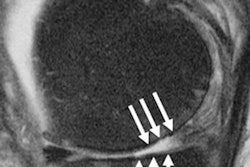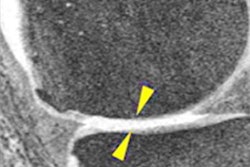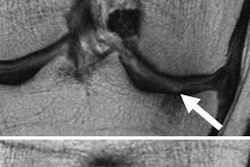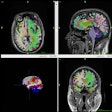MRI scans show that corticosteroid injections for knee pain due to osteoarthritis can accelerate joint damage, according to a study published May 27 in Radiology.
The study provides an imaging perspective to the ongoing debate regarding the use of intra-articular injections for clinical management of the disease, noted lead author Upasana Bharadwaj, MD, of the University of California, San Francisco, and colleagues.
“Our study directly challenges a common clinical practice: the use of corticosteroid injections for knee osteoarthritis symptom relief. It presents robust evidence that corticosteroids accelerate structural knee degeneration, even after a single injection,” Bharadwaj said in an RSNA news release.
Osteoarthritis is one of the most common chronic, degenerative, and progressive conditions of the knee joint, with more than 10% of all patients receiving injectable corticosteroids or hyaluronic acid to manage pain and improve joint function, the authors explained. These injections serve as the last nonsurgical treatment that can potentially delay joint replacement, they added.
While both have been shown to help with symptomatic pain relief, their long-term effects on knee osteoarthritis progression remain inconclusive, they noted. Moreover, no studies have evaluated isolated MRI features in these patients using the Whole-Organ Magnetic Resonance Imaging Score, the researchers noted.
The team assessed data from 70 participants who had one injection in the knee with either corticosteroid (n = 44) or hyaluronic acid (n = 26) and who had knee MRIs taken before, at the time of, and two years after the injection. The investigators compared the outcomes with a control group of 140 individuals with similar characteristics who did not receive any injection.
According to the findings, corticosteroid injections led to more knee joint damage over the two-year period than both the control group and those who received hyaluronic acid injections. In contrast, hyaluronic acid injections were linked to less progression of joint damage and even appeared to slow down the damage compared to before the injection, the group reported.
In addition, both types of injections helped reduce knee pain, but only hyaluronic acid seemed to help without causing further joint harm.
 Knee MRI scans in a 58-year-old female participant who was administered a corticosteroid injection. Sagittal intermediate-weighted images obtained (A) two years before injection, (B) at the time of injection, and (C) two years after injection show a focus on the medial femoral cartilage and trochlea. (C) The postinjection scan shows a new full-thickness cartilage lesion in the medial femoral cartilage (arrowhead), whereas images from the preinjection time points show a well-preserved medial femoral cartilage (A, B). The postinjection scan (C) also shows the development of a new full-thickness cartilage lesion in the medial femoral cartilage and a new bone marrow lesion in the trochlea (arrow), both of which were absent in the preinjection scans. These findings suggest structural deterioration following the corticosteroid injection.RSNA
Knee MRI scans in a 58-year-old female participant who was administered a corticosteroid injection. Sagittal intermediate-weighted images obtained (A) two years before injection, (B) at the time of injection, and (C) two years after injection show a focus on the medial femoral cartilage and trochlea. (C) The postinjection scan shows a new full-thickness cartilage lesion in the medial femoral cartilage (arrowhead), whereas images from the preinjection time points show a well-preserved medial femoral cartilage (A, B). The postinjection scan (C) also shows the development of a new full-thickness cartilage lesion in the medial femoral cartilage and a new bone marrow lesion in the trochlea (arrow), both of which were absent in the preinjection scans. These findings suggest structural deterioration following the corticosteroid injection.RSNA
“The most striking finding is that a single corticosteroid injection led to significantly greater structural damage in the knee joint over two years, especially in cartilage, while hyaluronic acid injections not only avoided this damage but actually showed reduced joint deterioration post-injection,” Bharadwaj said.
Ultimately, the study could lead to more judicious use of corticosteroid injections, especially for patients with mild to moderate osteoarthritis who are not yet surgical candidates, Bharadwaj said, noting that clinicians may opt for hyaluronic acid injections more frequently or consider alternative pain management strategies that don't accelerate structural deterioration.
“The public impact is significant, as osteoarthritis is a major global cause of disability, and millions receive such injections annually,” she concluded.
The full study can be found here.




.fFmgij6Hin.png?auto=compress%2Cformat&fit=crop&h=100&q=70&w=100)




.fFmgij6Hin.png?auto=compress%2Cformat&fit=crop&h=167&q=70&w=250)











